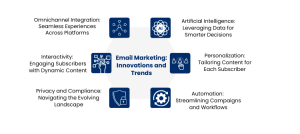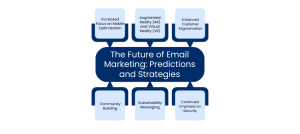to us to know how to promote business on the World Wide Web. We tell
them about different strategies that they can use different stages of their growth.
ContactUs
- +91-810-362-8856
- 106, Silver Arc Plaza, Janjeerwala Square, Indore – 452001, MP, India
-
Mon-Fri: 9am-8pm
Sat: 10am-6pm
Sun: Closed
Follow Us
Email Marketing: Innovations and Trends
Email marketing continues to be a vital component of a brand’s digital strategy, especially as consumer expectations evolve. With new technologies and methodologies emerging, marketers must stay ahead of the curve. This article explores the latest innovations and trends in email marketing, including personalization, automation, interactivity, omnichannel integration, artificial intelligence, and privacy compliance.

Personalization: Tailoring Content for Each Subscriber
Personalization is no longer a luxury; it has become an expectation. Consumers today are inundated with messages, making it imperative for brands to stand out. By leveraging data analytics, marketers can segment their audiences based on various criteria such as demographics, past behaviors, and preferences. This segmentation allows for highly tailored content that resonates with individual subscribers.
For instance, personalized subject lines and content can significantly improve open rates and engagement. Recommendations based on previous purchases or tailored offers for special occasions (like birthdays or anniversaries) can lead to increased conversion rates. Furthermore, as technology advances, the ability to create dynamic content—where elements change based on user data—will become even more prevalent, creating a more personalized experience for each subscriber.
Related content: The Power of Personalization: How to Tailor Your Digital Marketing Strategy in 2024
Automation: Streamlining Campaigns and Workflows
Email automation is transforming how brands communicate with their audience. Automation allows marketers to set up workflows that trigger emails based on user behavior, such as signing up for a newsletter, making a purchase, or abandoning a shopping cart. This not only saves time but also guarantees that messages are both timely and relevant.
Automated campaigns can include welcome emails, follow-ups, and re-engagement messages. For example, a welcome series can introduce new subscribers to your brand, setting the tone for future interactions. By automating these processes, marketers can maintain consistent communication with their audience, nurturing leads and driving conversions more efficiently.
Interactivity: Engaging Subscribers with Dynamic Content
In an age where attention spans are short, interactivity in emails can significantly enhance engagement. Traditional emails are often static, but incorporating interactive elements such as polls, quizzes, or videos can make them more engaging. This interactivity not only captures attention but also encourages subscribers to take action.
For example, a fashion retailer might include a style quiz in an email, allowing subscribers to select outfits that match their preferences. The results can then lead to personalized product recommendations. Such engagement can increase click-through rates and create a more enjoyable experience for the subscriber, ultimately fostering loyalty and encouraging further interaction with the brand.
Omnichannel Integration: Seamless Experiences Across Platforms
As consumers interact with brands through various channels, an omnichannel approach is essential. This strategy ensures that marketing efforts are cohesive and consistent, providing a seamless experience across email, social media, websites, and mobile apps.
For instance, a brand may use email to drive traffic to its social media pages, encouraging subscribers to engage with the brand in multiple ways. Integrating email campaigns with social media advertising can reinforce messaging and improve overall brand recognition. By tracking user behavior across these channels, marketers can create tailored experiences that resonate with customers at every touchpoint.
Artificial Intelligence: Leveraging Data for Smarter Decisions
Artificial intelligence is revolutionizing email marketing by providing insights and capabilities that were previously unattainable. AI tools can analyze vast amounts of data to identify patterns and trends, allowing marketers to make data-driven decisions.
Predictive analytics can forecast subscriber behavior, enabling brands to optimize send times and content based on individual preferences. AI can also assist in crafting compelling subject lines, automating content generation, and personalizing messages at scale. By leveraging AI, marketers can improve targeting and enhance the overall effectiveness of their email campaigns, ultimately leading to higher ROI.
You may also like: How AI is Transforming Digital Marketing?
Privacy and Compliance: Navigating the Evolving Landscape
With the rise of data privacy concerns, compliance with regulations such as GDPR and CCPA is more critical than ever. Brands must prioritize transparency regarding how they collect, store, and use subscriber data.
This requires implementing clear opt-in processes and offering easy opt-out options. Marketers must also ensure that they are not only compliant but also build trust with their audience by communicating their privacy practices clearly. By prioritizing ethical data handling, brands can foster positive relationships with subscribers, which is crucial in maintaining a loyal customer base.
The Future of Email Marketing: Predictions and Strategies

Looking ahead, several trends are likely to shape the future of email marketing:
1. Increased Focus on Mobile Optimization:
As mobile usage continues to rise, ensuring emails are optimized for mobile devices will be crucial. This encompasses responsive designs and fast loading times.
2. Augmented Reality (AR) and Virtual Reality (VR):
Incorporating AR and VR into email campaigns could provide immersive experiences that engage subscribers on a new level. For instance, a retailer might allow customers to visualize how furniture would look in their homes through AR.
3. Enhanced Customer Segmentation:
As data analytics tools become more sophisticated, marketers will be able to segment their audience more granularly, allowing for even more targeted campaigns that yield better results.
4. Sustainability Messaging:
As consumers become more environmentally conscious, brands that effectively communicate their sustainability efforts in their email campaigns will likely resonate well with this audience.
5. Community Building:
Brands will increasingly focus on building communities around their products and services. Email can serve as a platform for discussions and sharing user-generated content, creating a sense of belonging.
6. Continued Emphasis on Security:
As data breaches become more prevalent, brands must prioritize security in their email marketing strategies. Implementing robust security measures and communicating these efforts can enhance trust among subscribers.
Conclusion
Email marketing is at the forefront of innovation, with emerging trends shaping the way brands connect with their audiences. By embracing personalization, automation, interactivity, and AI, marketers can create engaging and effective campaigns that resonate with consumers. As the landscape continues to evolve, brands that prioritize privacy and ethical practices will foster trust and loyalty. The future of email marketing holds immense potential for those willing to adapt and innovate, ensuring they remain competitive in an ever-changing digital landscape.
